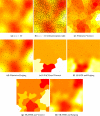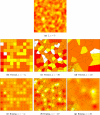Data driven performance evaluation of Wireless Sensor Networks
- PMID: 22294920
- PMCID: PMC3264473
- DOI: 10.3390/s100302150
Data driven performance evaluation of Wireless Sensor Networks
Abstract
Wireless Sensor Networks are presented as devices for signal sampling and reconstruction. Within this framework, the qualitative and quantitative influence of (i) signal granularity, (ii) spatial distribution of sensors, (iii) sensors clustering, and (iv) signal reconstruction procedure are assessed. This is done by defining an error metric and performing a Monte Carlo experiment. It is shown that all these factors have significant impact on the quality of the reconstructed signal. The extent of such impact is quantitatively assessed.
Keywords: reconstruction; sampling; simulation; statistical modeling; wireless sensor networks.
Figures







References
-
- Akyildiz I.F., Su W., Sankarasubramaniam Y., Cyirci E. A survey on sensor networks. Comput. Netw. 2002;38:393–422.
-
- Römer K., Friedemann M. The design space of wireless sensor networks. IEEE Wirel. Commun. 2004;11:54–61.
-
- Yick J., Mukherjee B., Ghosal D. Wireless sensor network survey. Comput. Netw. 2008;52:2292–2330.
-
- Cui J.H., Kong J., Gerla M., Zhou S. The challenges of building scalable mobile underwater wireless sensor networks for aquatic applications. IEEE Netw. 2006;20:12–18.
-
- Younis O., Krunz M., Ramasubramanian S. Node clustering in wireless sensor networks: recent developments and deployment challenges. IEEE Netw. 2006;20:20–25.
MeSH terms
LinkOut - more resources
Full Text Sources

